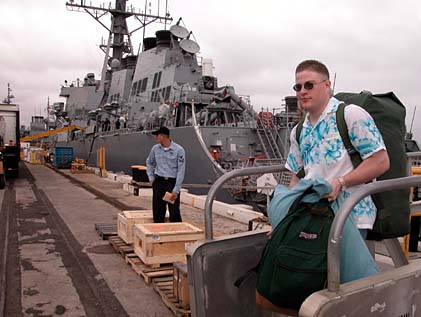
CRAIG T. KOJIMA / CKOJIMA@STARBULLETIN.COM
The San Diego-based destroyer USS Higgins arrived at Pearl Harbor yesterday for an overnight stay. Petty Officer 3rd Class Aaron Massey got off the Higgins to catch his flight home to Oregon.
‘Sea swap’ cuts
warship transitsPearl Harbor greets a destroyer
that took part in the experiment
The San Diego-based destroyer USS Higgins, which pulled into Pearl Harbor yesterday for an overnight stay, has deployed to the Persian Gulf for nearly 18 months, but its crew has been aboard for only six months.
That is because the 505-foot Arleigh Burke-class guided-missile destroyer has been part of a Navy experiment, called "sea swap," designed to reduce transit time while increasing the Navy's presence in places like the Persian Gulf.
The "sea swap" experiment called for one destroyer to stay on duty for about 400 days. Every six months, a new crew from a similar vessel was flown from San Diego to the deployed warship. The difference was that only one destroyer had to steam the more than 11,000 nautical miles from San Diego to the Persian Gulf and back.
Cmdr. Roy Kitchener, the Higgins' skipper, said the experiment added one extra Persian Gulf deployment by a destroyer, making four for the price of three.
This began 18 months ago when the first crew of 300 sailors left San Diego with the Higgins, Kitchener said. Six months later, a new Navy crew from the destroyer USS Benfold relieved the sailors on the Higgins.
"Last October, we flew out of San Diego from the USS John Paul Jones," Kitchener said, "and married up with our ship in the Arabia (Persian) Gulf, and after a five-day turnover, we were immediately operational."
"It's unique," said Kitchener, a 19-year Navy veteran, "because it takes a ship six weeks to go there from San Diego. We did it in a day by flying and were operating in a week."
Kitchener pointed out that another group of warships that left San Diego in August got to the Persian Gulf at the same time.
"If you look at actual time in the Arabian Gulf, on station as we call it," Kitchener said, "and not transiting to there and back, the Higgins got four deployments where a normal rotation cycle would be three."
A similar crew swap occurred with the Pearl Harbor-based destroyer USS Fletcher, which will not be returning home to Hawaii in June, but will be decommissioned in San Diego.
Command Master Chief Petty Officer Tim Corlew, the highest-ranking noncommissioned sailor on the Higgins, said he did not see much difference between this deployment and many others he has been on during his 26 years in the Navy.
"The only difference, Corlew said, "was that we only got one port to visit. ... Normally we get to visit two to three ports."
Corlew said "there were no major difficulties. People were a little anxious. It was a new ship, and you only had a few days to get ready to go out and do your job."
During Higgins' time in the Persian Gulf, the crew boarded 300 small vessels looking for contraband arms and other items, Kitchener said.
There was one rescue operation where the Higgins helped three Pakistani sailors who had been stranded for seven days without power, water and food.
As for the future of "sea swap," Kitchener said: "I think what we are trying to do is to see how well a ship will last on station for 18 months. ... I think she looks pretty good. ... They are looking how to apply it to other ships."
